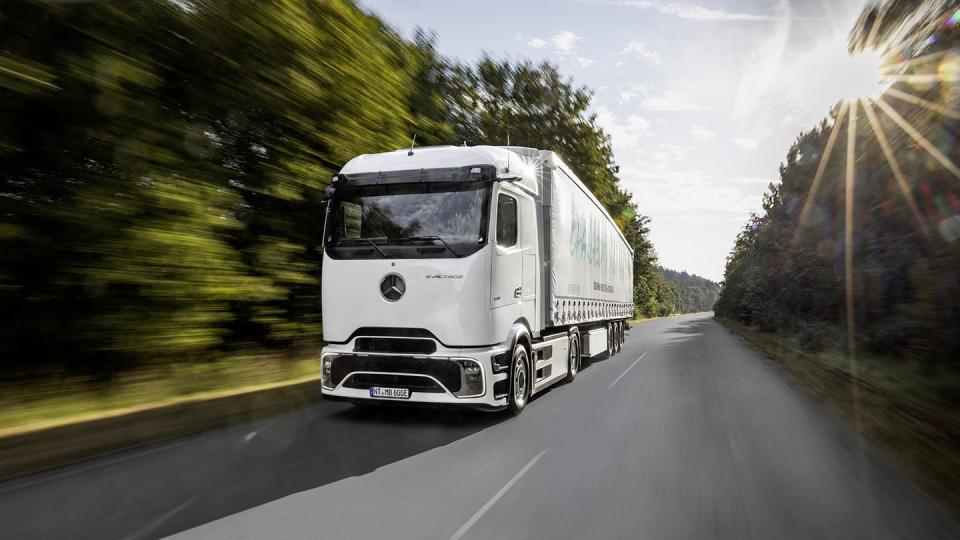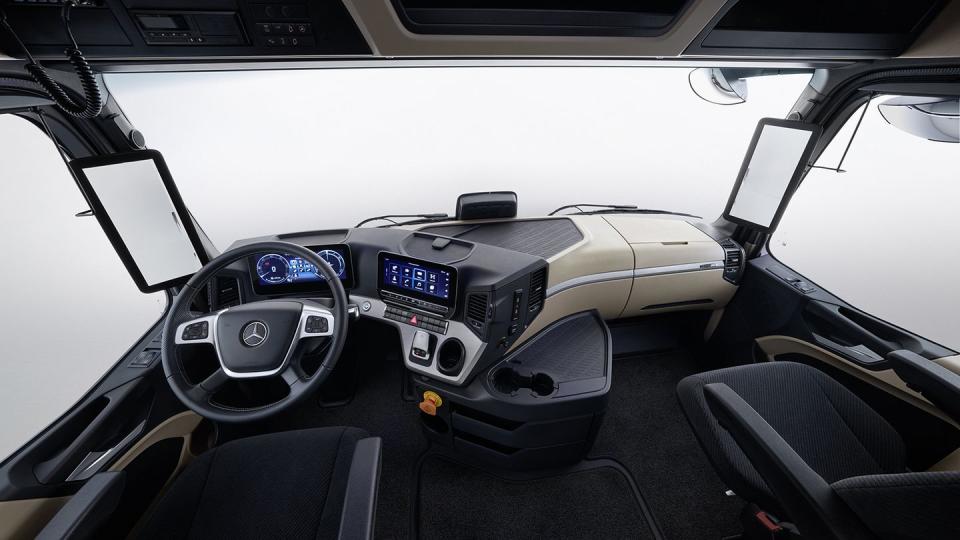Mercedes’ Long-Haul Electric Semi Is Ready for the Road

Mercedes-Benz reveals production version of eActros 600 semi, offering a range of 310 miles on a single charge thanks to a 600-kWh battery.
The eActros 600, joining existing electric truck offerings from Mercedes-Benz, is the company's first to be aimed at long-haul routes as opposed to medium-duty trucks for daily routes.
Mercedes-Benz says the adoption of electric trucks will require an expanded infrastructure, including megawatt-level charging, as well as government incentives encouraging the switch to electric vehicles.
Most of the focus right now in the commercial electric vehicle space is still on last-mile delivery vehicles, the kind employed by Amazon and other retailers. But there is also considerable movement at the opposite end of the size spectrum.
Mercedes-Benz has taken the wraps off its latest electric Class 8 semi truck, one aimed at long-haul routes rather than local deliveries or drayage. Dubbed the eActros 600, denoting battery size in kWh, the model was engineered to travel 500 kilometers or 310 miles between recharges, with Mercedes saying the truck can travel over 1000 kms (621 miles) in a single day with legally required driver breaks in between.
At least where the refueling infrastructure will permit such charging, one could add.
The eActros 600 currently supports CCS charging up to 400 kW, but in the future it will also enable megawatt charging (MCS). That's the secret ingredient in juicing up a 600-kWh battery—unthinkable at most public charging stations today.
Of course, these trucks won't be using public stations at all, as they will rely on a string of charging plazas currently planned along several major routes in Europe, linking port cities with manufacturing hubs.
Once megawatt charging becomes a reality, Mercedes plans to retrofit these trucks accordingly, allowing them to charge from 20% to 80% in approximately 30 minutes.
"Around 60% of long-distance journeys of Mercedes-Benz Trucks customers in Europe are shorter than 500 kilometers anyway, which means charging infrastructure at the depot and at loading and unloading points is sufficient in such cases," the truck maker points out.
With a payload of about 22 tonnes, and a gross combination weight of 44 tonnes, the eActros will indeed aim to replace diesel models that have formed the backbone of Europe's long-haul truck fleet for decades. The process itself could take well over a decade just in the EU, with an absence of legislation mandating EV trucks by some future date, unlike with passenger cars.

Mercedes-Benz will start selling the eActros 600 this year, with the model joining Mercedes' growing truck fleet that started out focused on medium-duty box trucks. But it will certainly be a while before cost parity is achieved in some fashion, whether through significant drops in the cost of batteries, legislation, or through economic measures.
"The time period within which fleet operators can achieve cost parity with a comparable diesel truck using the eActros 600 in long-distance haulage differs from country to country, in particular depending on electricity and diesel prices and toll systems," the truck maker notes.
Electricity costs even among EU countries can differ quite a bit, with Mercedes hoping a range of measures including subsidies and a CO2 toll for diesel trucks will help tilt the balance in favor of electric trucks in the long run.
But the most pressing practical barrier to adoption, aside from cost, will certainly be truck charging infrastructure and the current absence of megawatt-level charging that will make trucks with a 600-kWh battery more palatable to fleets.
Among fleets, the one sub-sector of the trucking industry that has been relatively quick to embrace electric semis has been drayage operations, with port-based charging infrastructure and short runs to warehouses. But even such fleets with their own infrastructure exist on a very small scale at the moment.
The adoption of long-haul electric semis, on the other hand, is likely to face greater infrastructure challenges than drayage fleets.
Will we see electric long-haul trucks appear in any meaningful number in the US in this decade, or will this process take much longer? Let us know in the comments below.

 Yahoo Autos
Yahoo Autos 